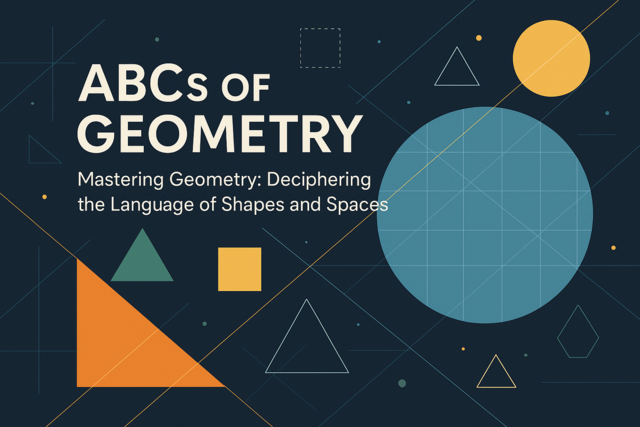Online Class: Geometry 101 — Beginner to Intermediate Level

-
15Lessons
-
38Exams &
Assignments -
17Hours
average time -
1.7CEUs
Course Description
Imagine a world without shape or form, where chaos reigns, and the beauty of symmetry is absent. It's our uncanny ability to interpret the language of geometry that disentangles our perception and breathes order into our universe. Geometry 101 is not merely a course; it's an odyssey through the mathematical symphony that orchestrates the dance of points, lines, and planes, transforming the abstract into the tangible. This course is your gateway to unraveling the vast tapestry of spatial intelligence and leveraging it to enrich every facet of your life.
Step forward into a world where walls whisper stories of angles, where streets and skyscrapers pulse with the logic of lines and shapes. With Geometry 101, you are about to embark on an unforgettable journey, where your guide is not just knowledge, but the power to see the world through a lens of elegance and precision that only geometry can provide.
Each unit of this immersive course is crafted meticulously to weave a seamless tapestry from the rudiments of geometric principles to the nuanced symphony of spatial reasoning. You will begin your exploration with simple points and lines, nurturing your innate curiosity about how these simple constructs form the essence of everything. Soon, you will find yourself navigating the complex interplay of angles and intersections, developing the keen eye necessary to recognize the universe's subtle geometric rhythm.
Venturing into the realm of polygons, you will unravel the mystique of triangles and quadrilaterals, breathing life into these foundational forms. You'll learn to harness their properties, cultivating an understanding as timeless as the pyramids, as profound as the humble honeycomb's hexagonal perfection. This mastery will elevate your capacity to seamlessly transition to the more sophisticated art of constructing and deconstructing composite shapes--an architectural dance of creativity and logic.
The journey doesn't stop at two dimensions. With Geometry 101, you transcend the boundaries of the flat surface. Our exploration ascends into three-dimensional space, offering profound insights into the solid realities of spheres, polyhedra, and the kaleidoscopic interplay of planes. Learn to dissect complexity with clarity and precision, as you unravel the mysteries of volumes and surfaces that define not just objects but the very nature of the space they inhabit.
But why merely follow others? Why not grasp the reins of your geometric destiny and conjure your own constructs? Geometry 101 equips you with this power, taking you beyond theoretical realms to the time-honored art of classical construction. With a compass and straightedge, your sketches evolve from rudimentary lines to masterpieces of innovation and precise beauty--a dance of geometry that transcends mere calculation.
Geometry 101 isn't just about learning; it's about transformation. It's about cultivating a mindset that recognizes the unseen bonds between the abstract world of numbers and the tactile experiences of reality. By the end of this course, you'll possess not only the mathematical prowess to solve geometric conundrums but the confidence to apply this knowledge in real-world scenarios. Your newfound skills in trigonometry will embolden you to navigate a world layered with geometric challenges, whether in technology, design, or day-to-day problem-solving.
Choose Geometry 101 and don't just study geometry--inhabit it. Let it reshape your perspective, refine your talents, and redefine excellence. This course is not just an educational endeavor but the laying of fertile ground where curiosity flowers into mastery. Let Geometry 101 steer you toward the future you're dreaming of--join us, and transform the way you see, think, and shape the world around you. The path to enlightenment is geometric; let yours begin here.
- Business
- Business Ethics Courses
- Harassment Prevention Courses
- Human Resources Certifications
- Management
- Aromatherapy Courses
- Caregiver Courses
- Career Development Courses
- Communications Courses
- Confidence and Self Esteem Courses
- Healing
- Human Anatomy Courses
- Medical Skills
- Health & Medicine
- Nutrition
- Marketing
- Microsoft Office Certification Courses
- Life Coaching Courses
- Self-Improvement
- Small Business Certifications
- Safety
- Writing Improvement
- Business Writing Courses
Course Lessons
Lesson 1. Foundations of Geometry and Their Practical Applications
 Lesson 1 Video
Lesson 1 Video Lesson discussions: Reasons for Taking this Course
Lesson discussions: Reasons for Taking this Course Assessment: Lesson 1 Geometry Terms and Motivation
Assessment: Lesson 1 Geometry Terms and Motivation Assessment: Lesson 1 Exercises
Assessment: Lesson 1 Exercises Assessment: Lesson 1 Review Exam
Assessment: Lesson 1 Review Exam
Lesson 2. Deductive Reasoning: A Deep Dive into Geometry
 Lesson 2 Video
Lesson 2 Video Complete: Lesson 2 Activity
Complete: Lesson 2 Activity Assessment: Lesson 2 Geometric Reasoning and Measurement
Assessment: Lesson 2 Geometric Reasoning and Measurement Assessment: Lesson 2 Review Exam
Assessment: Lesson 2 Review Exam
Lesson 3. Angles and Parallel Lines in Geometry
 Lesson 3 Video
Lesson 3 Video Assessment: Lesson 3 Angles and Parallelism
Assessment: Lesson 3 Angles and Parallelism Assessment: Lesson 3 Review Exam
Assessment: Lesson 3 Review Exam
Lesson 4. Decoding the Secrets of Triangles: Types and Properties
 Lesson 4 Video
Lesson 4 Video Complete: Lesson 4 Activity
Complete: Lesson 4 Activity Assessment: Lesson 4 Triangles I: Properties of Triangles
Assessment: Lesson 4 Triangles I: Properties of Triangles Assessment: Lesson 4 Exercises
Assessment: Lesson 4 Exercises Assessment: Lesson 4 Review Exam
Assessment: Lesson 4 Review Exam
Lesson 5. Mastering Congruent Triangles: A Study of Geometric Similarities
 Lesson 5 Video
Lesson 5 Video Complete: Lesson 5 Activity
Complete: Lesson 5 Activity Assessment: Lesson 5 Triangles II: Congruent Triangles
Assessment: Lesson 5 Triangles II: Congruent Triangles Assessment: Lesson 5 Exercises
Assessment: Lesson 5 Exercises Assessment: Lesson 5 Review Exam
Assessment: Lesson 5 Review Exam
Lesson 6. Triangles and Transformation: Discovering Similarity
 Lesson 6 Video
Lesson 6 Video Assessment: Lesson 6 Triangles III: Similar Triangles
Assessment: Lesson 6 Triangles III: Similar Triangles Assessment: Lesson 6 Review Exam
Assessment: Lesson 6 Review Exam
Lesson 7. Quadrilaterals Unlocked: From Basic Shapes to Calculating Areas
 Lesson 7 Video
Lesson 7 Video Assessment: Lesson 7 Quadrilaterals
Assessment: Lesson 7 Quadrilaterals Assessment: Lesson 7 Review Exam
Assessment: Lesson 7 Review Exam
Lesson 8. Polygon Perimeters and Properties
 Lesson 8 Video
Lesson 8 Video Assessment: Lesson 8 Polygons
Assessment: Lesson 8 Polygons Assessment: Lesson 8 Exercises
Assessment: Lesson 8 Exercises Assessment: Lesson 8 Review Exam
Assessment: Lesson 8 Review Exam
Lesson 9. Understanding Circles: Essential Concepts and Calculations
 Lesson 9 Video
Lesson 9 Video Complete: Lesson 9 Activity
Complete: Lesson 9 Activity Assessment: Lesson 9 Circles
Assessment: Lesson 9 Circles Assessment: Lesson 9 Review Exam
Assessment: Lesson 9 Review Exam
Lesson 10. Exploring the World of Composite Figures: An Analytical Journey
 Lesson 10 Video
Lesson 10 Video Assessment: Lesson 10 Composite Figures
Assessment: Lesson 10 Composite Figures Assessment: Lesson 10 Review Exam
Assessment: Lesson 10 Review Exam
Lesson 11. Pencil and Compass: The Art of Classical Constructions
 Lesson 11 Video
Lesson 11 Video Assessment: Lesson 11 Classical Construction
Assessment: Lesson 11 Classical Construction Assessment: Lesson 11 Review Exam
Assessment: Lesson 11 Review Exam
Lesson 12. Hands-On Geometry: Applying What You've Learned
 Lesson 12 Video
Lesson 12 Video Complete: Lesson 12 Activity
Complete: Lesson 12 Activity Assessment: Lesson 12 Practical Geometry Problems
Assessment: Lesson 12 Practical Geometry Problems Assessment: Lesson 12 Review Exam
Assessment: Lesson 12 Review Exam
Lesson 13. Parallelism and Perpendicularity Beyond Two Dimensions
 Lesson 13 Video
Lesson 13 Video Complete: Lesson 13 Activity
Complete: Lesson 13 Activity Assessment: Lesson 13 Three-Dimensional Geometry I
Assessment: Lesson 13 Three-Dimensional Geometry I
Lesson 14. Advanced Exploration of Polyhedra and 3D Shapes: Volume and Surface Analysis
 Lesson 14 Video
Lesson 14 Video Assessment: Lesson 14 Three-Dimensional Geometry II
Assessment: Lesson 14 Three-Dimensional Geometry II
Lesson 15. Introduction to Trigonometry: Understanding Angles and Sides
 Lesson 15 Video
Lesson 15 Video Lesson discussions: End of Course Poll; Course Comments
Lesson discussions: End of Course Poll; Course Comments Assessment: Lesson 15 Geometry and Trigonometry
Assessment: Lesson 15 Geometry and Trigonometry Assessment: The Final Exam
Assessment: The Final Exam
Learning Outcomes
- Identify and describe fundamental geometric figures such as points, lines, rays, and planes by illustrating them accurately with examples.
- Recognize the importance of geometry in daily life, academia, and professional settings by providing three examples of practical applications.
- Define deductive reasoning and demonstrate deriving conclusions from given premises.
- Explain the importance of units in geometric measurement and demonstrate using arbitrary units for measurement.
- Recognize and construct a two-column proof for basic geometric problems.
- Demonstrate understanding of angle relationships and properties when a transversal intersects two parallel lines.
- Identify and calculate the measures of angles formed by intersecting lines using degree measurements.
- Calculate the length of a side in a right triangle using the Pythagorean theorem.
- Identify and classify triangles as equilateral, isosceles, or scalene based on side lengths and angles.
- Demonstrate congruence between two triangles using the hypotenuse-leg (HL) condition in right triangles.
- Recognize and justify the four conditions (SSS, SAS, ASA, AAS) for triangle congruence through geometric reasoning.
- Prove the similarity of any two given triangles by applying the appropriate conditions such as angle-angle, side-side-side proportionality, or side-angle-side proportionality.
- Demonstrate how to use geometric transformations to show two triangles are similar, including dilation and translation, within a structured problem-solving process.
- Demonstrate mastery of lesson content at levels of 70% or higher.
Additional Course Information

- Document Your Lifelong Learning Achievements
- Earn an Official Certificate Documenting Course Hours and CEUs
- Verify Your Certificate with a Unique Serial Number Online
- View and Share Your Certificate Online or Download/Print as PDF
- Display Your Certificate on Your Resume and Promote Your Achievements Using Social Media

Student Testimonials
- "Course was a bit difficult for me, instructor was available and helped me when I needed help!" -- Marcus M.
- "This was a great course. I learned a lot about Geometry and am excited to use what I learned here in my high school. It was definitely better than some of the other Universal courses I took because this instructor, Mr. Clark, was more organized and thorough with his lessons, and it was easier to understand him than other university's instructors." -- Hannah Z.
- "He was an excellent teacher...the lessons were very clear and easy to understand. I also like the 15 lesson layout." -- Rayna K.
Related Courses
-
 6 hours
0.6 CEUs
Sustainable Development for Business
+ More Info
6 hours
0.6 CEUs
Sustainable Development for Business
+ More Info
-
 7 hours
0.7 CEUs
Organizational Behavior in Business
+ More Info
7 hours
0.7 CEUs
Organizational Behavior in Business
+ More Info
-
 4 hours
0.4 CEUs
Business Analysis
+ More Info
4 hours
0.4 CEUs
Business Analysis
+ More Info
-
 8 hours
0.8 CEUs
Teaching Grammar to ESL Students
+ More Info
8 hours
0.8 CEUs
Teaching Grammar to ESL Students
+ More Info
-
 12 hours
1.2 CEUs
Business Math 101
+ More Info
12 hours
1.2 CEUs
Business Math 101
+ More Info
-
 7 hours
0.7 CEUs
Introduction to Logic
+ More Info
7 hours
0.7 CEUs
Introduction to Logic
+ More Info






